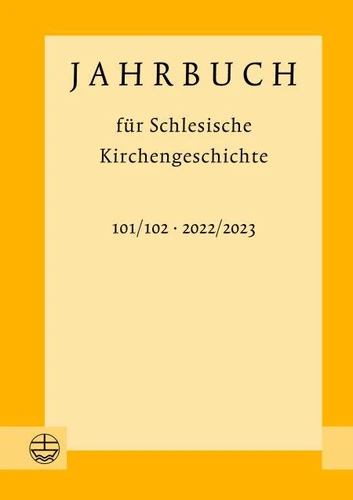Jahrbuch für Schlesische Kirchengeschichte. 101/102 (2022/2023)
Par :Formats :
Disponible dans votre compte client Decitre ou Furet du Nord dès validation de votre commande. Le format PDF est :
- Compatible avec une lecture sur My Vivlio (smartphone, tablette, ordinateur)
- Compatible avec une lecture sur liseuses Vivlio
- Pour les liseuses autres que Vivlio, vous devez utiliser le logiciel Adobe Digital Edition. Non compatible avec la lecture sur les liseuses Kindle, Remarkable et Sony
 , qui est-ce ?
, qui est-ce ?Notre partenaire de plateforme de lecture numérique où vous retrouverez l'ensemble de vos ebooks gratuitement
Pour en savoir plus sur nos ebooks, consultez notre aide en ligne ici
- Nombre de pages324
- FormatPDF
- ISBN978-3-374-07595-9
- EAN9783374075959
- Date de parution22/03/2024
- Protection num.Digital Watermarking
- Taille3 Mo
- Infos supplémentairespdf
- ÉditeurEvangelische Verlagsanstalt
Résumé
Der Schwerpunkt des Jahrbuches liegt auf den Themen Reformation in Schlesien und der Herrnhuter Brüdergemeine in Schlesien. Dazu gibt es zum einen Beiträge zu »Der junge Johannes Hess und seine Bedeutung für die Breslauer Reformation« (Thomas Kaufmann), »Der Oderraum als Kernregion der Reformation?« (Andreas Stegmann) und »Innerprotestantische Auseinandersetzungen in Schlesien« (Gabriele Was), zum anderen zu »Die Brüdergemeine als Sammelbecken des schlesischen Pietismus und ihre Widersacher« (Dietrich Meyer), »Die Familie Schleiermacher und die Brüdergemeine in Schlesien« (Simon Gerber), »Die schlesische Brüdergemeine als Wirtschaftsfaktor in der Weltwirtschaftskrise« (Susanne Kokel) und »Diakonissen der schlesischen Brüdergemeine in Jerusalem« (Angela Koppehl).
[Yearbook of Silesian Church History] The focus of the yearbook is on the topics of the Reformation in Silesia and the Moravian Church in Silesia.
On the one hand, there are contributions on »The young Johannes Hess and his importance for the Wroclaw Reformation« (Thomas Kaufmann), »The Oder region as a core region of the Reformation?« (Andreas Stegmann) and »Inner-Protestant Disputes in Silesia« (Gabriele Was). On the other hand, there are contributions on »The Moravian Church as a Gathering Place of Silesian Pietism and its Adversaries« (Dietrich Meyer), »The Schleiermacher Family and the Moravians in Silesia« (Simon Gerber), »The Moravians in Silesia as an Economic Factor in the Great Depression« (Susanne Kokel), and »Deaconesses of the Silesian Moravians in Jerusalem« (Angela Koppehl).
On the one hand, there are contributions on »The young Johannes Hess and his importance for the Wroclaw Reformation« (Thomas Kaufmann), »The Oder region as a core region of the Reformation?« (Andreas Stegmann) and »Inner-Protestant Disputes in Silesia« (Gabriele Was). On the other hand, there are contributions on »The Moravian Church as a Gathering Place of Silesian Pietism and its Adversaries« (Dietrich Meyer), »The Schleiermacher Family and the Moravians in Silesia« (Simon Gerber), »The Moravians in Silesia as an Economic Factor in the Great Depression« (Susanne Kokel), and »Deaconesses of the Silesian Moravians in Jerusalem« (Angela Koppehl).
Der Schwerpunkt des Jahrbuches liegt auf den Themen Reformation in Schlesien und der Herrnhuter Brüdergemeine in Schlesien. Dazu gibt es zum einen Beiträge zu »Der junge Johannes Hess und seine Bedeutung für die Breslauer Reformation« (Thomas Kaufmann), »Der Oderraum als Kernregion der Reformation?« (Andreas Stegmann) und »Innerprotestantische Auseinandersetzungen in Schlesien« (Gabriele Was), zum anderen zu »Die Brüdergemeine als Sammelbecken des schlesischen Pietismus und ihre Widersacher« (Dietrich Meyer), »Die Familie Schleiermacher und die Brüdergemeine in Schlesien« (Simon Gerber), »Die schlesische Brüdergemeine als Wirtschaftsfaktor in der Weltwirtschaftskrise« (Susanne Kokel) und »Diakonissen der schlesischen Brüdergemeine in Jerusalem« (Angela Koppehl).
[Yearbook of Silesian Church History] The focus of the yearbook is on the topics of the Reformation in Silesia and the Moravian Church in Silesia.
On the one hand, there are contributions on »The young Johannes Hess and his importance for the Wroclaw Reformation« (Thomas Kaufmann), »The Oder region as a core region of the Reformation?« (Andreas Stegmann) and »Inner-Protestant Disputes in Silesia« (Gabriele Was). On the other hand, there are contributions on »The Moravian Church as a Gathering Place of Silesian Pietism and its Adversaries« (Dietrich Meyer), »The Schleiermacher Family and the Moravians in Silesia« (Simon Gerber), »The Moravians in Silesia as an Economic Factor in the Great Depression« (Susanne Kokel), and »Deaconesses of the Silesian Moravians in Jerusalem« (Angela Koppehl).
On the one hand, there are contributions on »The young Johannes Hess and his importance for the Wroclaw Reformation« (Thomas Kaufmann), »The Oder region as a core region of the Reformation?« (Andreas Stegmann) and »Inner-Protestant Disputes in Silesia« (Gabriele Was). On the other hand, there are contributions on »The Moravian Church as a Gathering Place of Silesian Pietism and its Adversaries« (Dietrich Meyer), »The Schleiermacher Family and the Moravians in Silesia« (Simon Gerber), »The Moravians in Silesia as an Economic Factor in the Great Depression« (Susanne Kokel), and »Deaconesses of the Silesian Moravians in Jerusalem« (Angela Koppehl).




